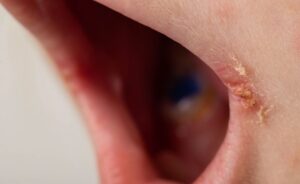1. What is Angular Cheilitis?
If you’re dealing with painful cracks at the corners of your mouth, you’re not alone. This common and treatable condition is called angular cheilitis, also known as perlèche. This guide will clarify what the condition is, what causes it, and what it looks like, providing a foundational understanding to help you manage it effectively.


Podcast:
Learn More About Angular Cheilities/Perleche
The cause of angular cheilitis can be understood as a three-step process:
- Constant moisture from saliva weakens the skin. This leads to maceration, which is the softening and breakdown of skin from being wet for too long—much like how your skin gets white and fragile after wearing a soggy bandage.
- This weakened skin becomes irritated.
- This warm, moist, irritated environment then becomes a perfect breeding ground for yeast (most commonly Candida albicans) that normally lives harmlessly on our skin, causing an overgrowth that leads to inflammation and cracking.
The common signs and symptoms of angular cheilitis often progress in stages:
- Early Signs: Redness and raw-looking skin at the corners of the mouth.
- Later Signs: The area may become raised, crusted, or develop small, painful cracks (fissures).
Understanding this condition is the first step. Next, we will explore the specific factors that make some individuals more likely to develop it.
2. Common Risk Factors: Why Do I Have This?
Identifying the specific factors that contribute to angular cheilitis is the first step toward effective management and prevention. While anyone can develop this condition, certain circumstances create the ideal environment for it to occur. Reviewing this list can help you pinpoint potential triggers in your own life.
- Infants: Young children are susceptible, especially if they also have oral thrush (a yeast infection inside the mouth).
- Older Adults: The loss of teeth or wearing poorly fitting dentures can change the structure of the jaw, causing the mouth to over-close slightly. This creates deeper folds at the corners where saliva can collect, leading to constant moisture.
- Orthodontic Devices: Braces and other appliances can trap moisture against the skin, creating a favorable environment for irritation.
- Certain Habits: Actions that keep the corners of the mouth moist, such as frequent lip licking, thumb sucking, or drooling during sleep, can directly contribute to the problem.
- Underlying Health Conditions: Individuals with diabetes or a weakened immune system may be more susceptible to infections. Likewise, those taking certain medications, such as antibiotics or steroids, can also be at higher risk.
Understanding these triggers is powerful because it points directly to the solutions we’ll discuss next: protecting the skin from moisture and addressing these contributing habits.
3. Self-Care: What You Can Do at Home
Many cases of angular cheilitis can be managed effectively with simple, over-the-counter strategies. This section focuses on practical steps you can take to help heal the skin, reduce irritation, and prevent the condition from returning.
Step 1: Create a Protective Barrier
The most critical step in self-care is to shield the delicate skin at the corners of your mouth from saliva. The key is to use a thick barrier ointment. These ointments are superior to standard lotions or creams because they are occlusive—they form a waterproof seal that lotions cannot, which is essential for preventing maceration and giving the skin a chance to heal.
- What to Use: Look for thick, simple ointments containing petrolatum or zinc oxide. A specific example is Desitin original formula.
- How to Use It: Apply the ointment consistently throughout the day. Most importantly, apply a protective layer before bed to guard your skin against potential nighttime drooling.
Step 2: Reduce Moisture-Trapping Habits
Be mindful of behaviors that keep the corners of your mouth wet. Try to reduce habits like lip licking, as this adds moisture and irritation to the already sensitive area.
While these self-care measures are often effective, it is important to know when professional medical advice is necessary.
4. When to See a Dermatologist
While self-care is a powerful first step, a provider’s diagnosis is essential for proper treatment and to rule out other conditions that can appear similar. Seeking professional medical care ensures you are on the right track for healing.
You should schedule a visit with a healthcare provider in the following situations:
- If your symptoms do not improve within a few weeks of trying at-home care.
- If the condition keeps coming back frequently, as there may be an underlying cause that needs to be addressed.
- To get an accurate diagnosis, as other conditions, such as herpes simplex, bacterial infections, allergic reactions, or even nutritional deficiencies, can look similar but require different treatments.
- Critically, if the sores are only on one side of your mouth and do not respond to treatment. This specific presentation requires a professional evaluation to rule out more serious issues.
With a proper diagnosis and treatment plan, the outlook for recovery is excellent.
5. Outlook and Prevention
It is natural to be concerned when dealing with a persistent skin condition, but the outlook for angular cheilitis is very positive. This final section will summarize the typical prognosis and reinforce the most effective strategy for preventing its recurrence.
With proper treatment—addressing the underlying causes and protecting the skin—angular cheilitis usually resolves completely within a few weeks. However, because the condition is tied to specific risk factors, it can return if those factors are not managed.
The key to staying comfortable is prevention. By making the consistent use of a barrier ointment a part of your daily routine, especially before bed, you can take control and significantly reduce the chances of it returning.
